With the much-anticipated release of the LEGO Ideas Orient Express (21344), LEGO train fans once again have a great deal to celebrate. Given that LEGO’s product release schedule for train theme sets is both infrequent and unpredictable, each release is that much more impactful and attracts its share of scrutiny from LEGO train fans.
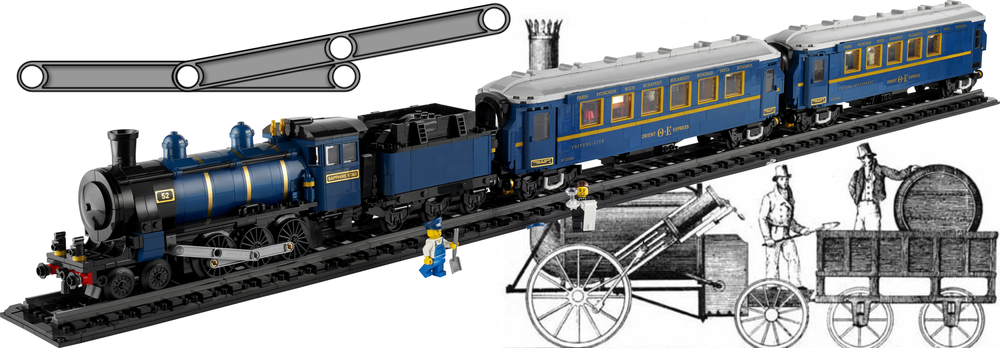
After building the new LEGO Orient Express, I can say it is special for a few reasons:
It's a steam train! Steam trains are definitely a minority subject compared to their diesel and electric peers.
Its chosen scale is 8-studs wide. For almost all of the span of LEGO train theme history, the nominal scale of locomotives and rolling stock has been 6-studs wide. The trend to bigger proportional scales started with the Disney Train (71044) in 2019 at 8-studs wide, followed by the Crocodile (10277) in 2020 at 7-studs wide.
Size. At nearly 140 studs long (over 1 m), it is a substantial consist. The consist configuration of a locomotive plus 2x full-size coaches is definitely more balanced. Especially compared to the Emerald Night (10194) with only one accompanying coach, the consist of the Orient Express consist looks balanced as-is. Furthermore, adding additional coaches by acquiring multiples of this set feels like better value for money in comparison.
New techniques. The Orient Express diverges from traditional train theme functional attributes in two key ways: i) ball-socket couplers instead of magnetic couplers; and ii) brick-built buffers instead of the typical one-piece buffer element.
New parts. As a train fan, the headline for me is the new coupling rod element—so much so that it is the main topic of this article. This is literally the missing "link" for effective steam locomotive train building for over three decades with the retirement of the 12V train theme.

The Orient Express gives us many different topics to explore and discuss. The LEGO fan media landscape will deservedly be saturated with set review coverage that comes with any substantial Ideas release. Comparisons will be made with the Emerald Night and the original source material. There will be conversations about how much a set can differ from the fan-submitted design. And there will be discussions on if and how the Orient Express can be motorized.
But I am more interested in exploring the Orient Express not only from the LEGO train fan perspective but also from technical/engineering exploration. The topic I feel compelled to explore is a fundamental functional component of almost any steam locomotive: its coupling (or side) rods. This is Brick-NERD after all!
What Are Coupling Rods?
The basic function of a steam locomotive is to convert the enormous potential energy of expanding steam vapour into mechanical work to move the locomotive. To capture the energy of expanding steam, a piston is used. Super-heated steam is injected into the piston cylinder where it rapidly expands and exerts a force against the piston head. The linear motion of the piston is then transferred to the wheels via one or more rods which push against a pivot point radially on the wheel. This exerts a turning torque on the wheel, and it rotates.
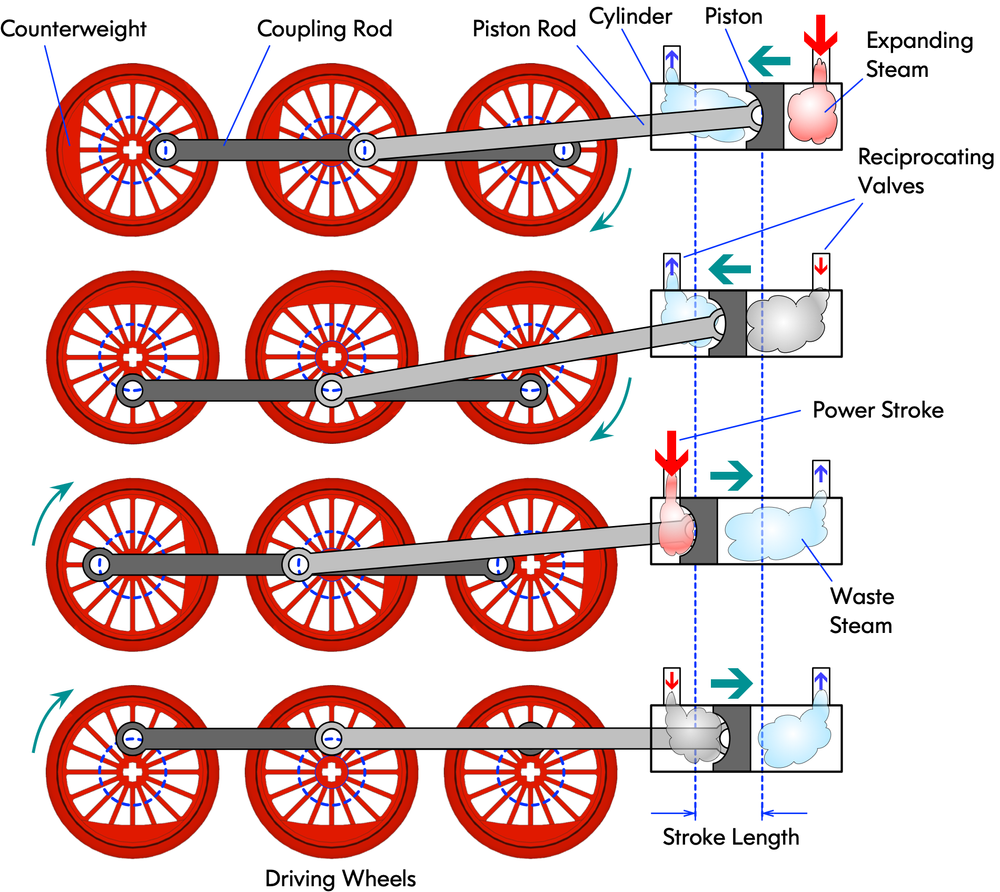
The linear motion of the piston extends over its stroke length. This stroke length corresponds to one-half rotation of the driving wheel. To maintain power over the full rotation of the driving wheel, the piston can be pushed from either direction with the use of reciprocating valves. These valves alternate the admission of steam into the cylinder from either side, allowing a power stroke twice per rotation.
This leaves two gaps of power transfer with uneven torque and less efficiency. Therefore, another piston (typically on the opposite side of the locomotive) acts in the same way but in a complementary phase. Each piston "takes turns" exerting a turning torque to the driving wheel and maintaining relatively constant power delivery.

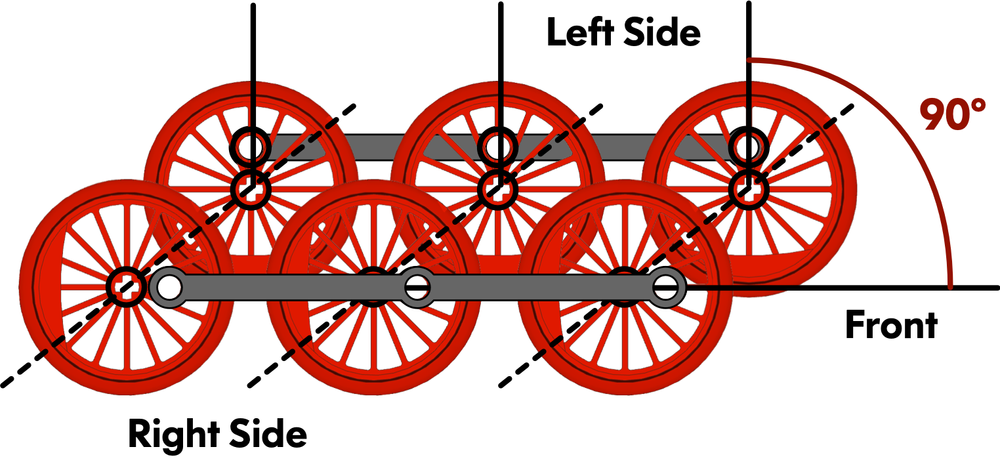
Wheel Quartering
One key topic when discussing steam locomotive operation is the topic of Wheel Quartering. This refers to the essential relative configuration of wheels on opposite sides of the locomotive being 90º offset from each other. This is required in order to ensure the proper sequencing of power to the wheels. In the diagram, there is always one power stroke every quarter rotation of the wheels. This ensures power is consistently applied over the entire rotation of the wheel.
Early steam locomotives, such as Stephenson's Rocket (shown below), typically had one driving axle with corresponding steam pistons. For the relatively light loads and power requirements of early steam trains, this was sufficient. However, as load and speed requirements grew, the ability of a single wheel to deliver all of the steam engine's power could not be sustained. The contact patch of a train wheel against the rail is a tiny surface area. If too much power is concentrated on the rotating wheel, it soon exceeds the frictional adhesion of the contact patch, and the wheel slips—similar to a car trying to accelerate on ice.

One of train history’s earliest and notorious steam locomotives: Stephenson’s “Rocket”
In order to address this limitation, more driving wheels are required to distribute the tractive force so that each wheel is operating within its adhesion limit. The problem now becomes delivering the steam piston's power to more than one driven axle. This is the primary role of the coupling rod. It mechanically links each of the driving wheels so that a force applied against this common linkage is applied equally to all of the wheels.
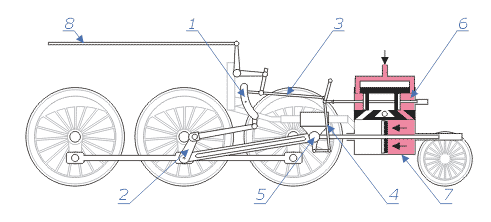
IMage via Wikipedia.
LEGO Coupling Rods
Now that we know what coupling rods are used for, let’s turn our attention to how this key mechanical function has been depicted with LEGO elements.
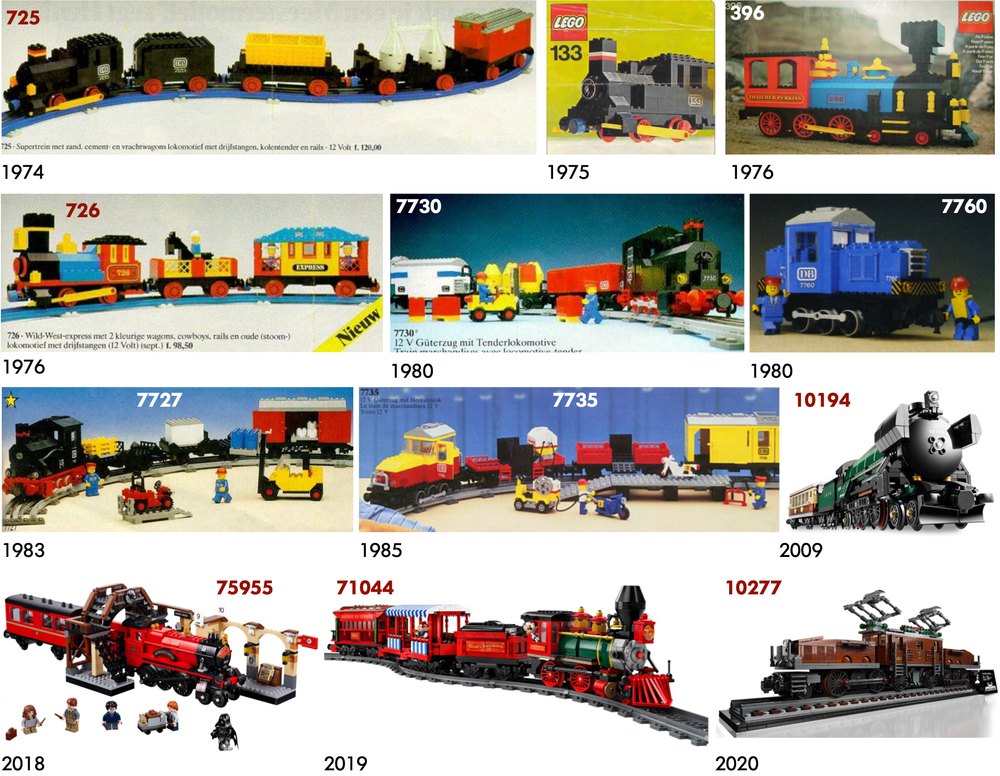
Coupling rods are part of the functional and visual essence of a steam locomotive. Their reciprocating motion adds to the mesmerizing effect of watching a steam locomotive in motion. The LEGO system, although rich with a diversity of elements today, did not start that way. Specialized functional elements such as coupling rods almost seem out of place in the LEGO system. We think of the LEGO system as a family of general-purpose building elements which we combine into whatever we want. Therefore, it is remarkable that the LEGO train system has had a few bespoke coupling rod elements in its history.
1970s Blue Rail Era
The earliest depictions of coupling rods can be found as early as 1974, not long after the introduction of LEGO trains in the late 1960s. The coupling rod function was implemented with two elements: the rod itself (x515) and a special cam overlay element (x564) which connects the rod to the wheel. This combination appeared in a few sets through the 1970s and most notably in combination with the large diameter wheel in set 396. This set really is an impressive model in the context of its time. It exploited as much detail as possible with the very limited selection of both elements and colours at that time.

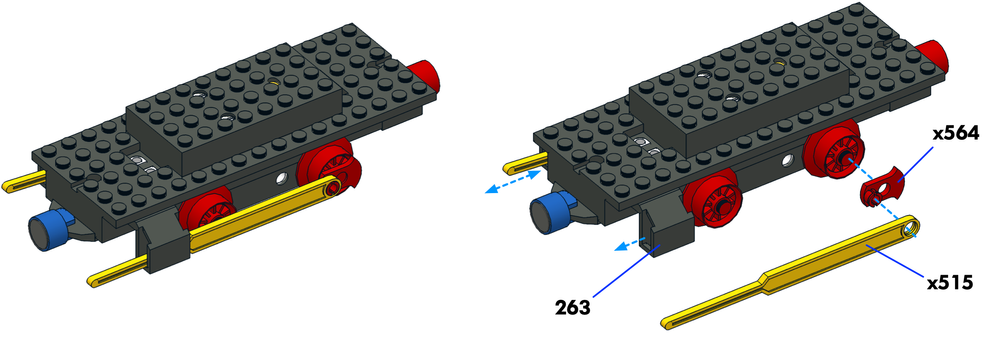
1980s 12V Era
With the turn of the decade in 1980, the LEGO train theme took a major leap forward into the classic 12V train era. I’ve often claimed that this was a so-called “golden era” for LEGO trains due to its variety of sets, generous system of electrical accessories and striking visual design.
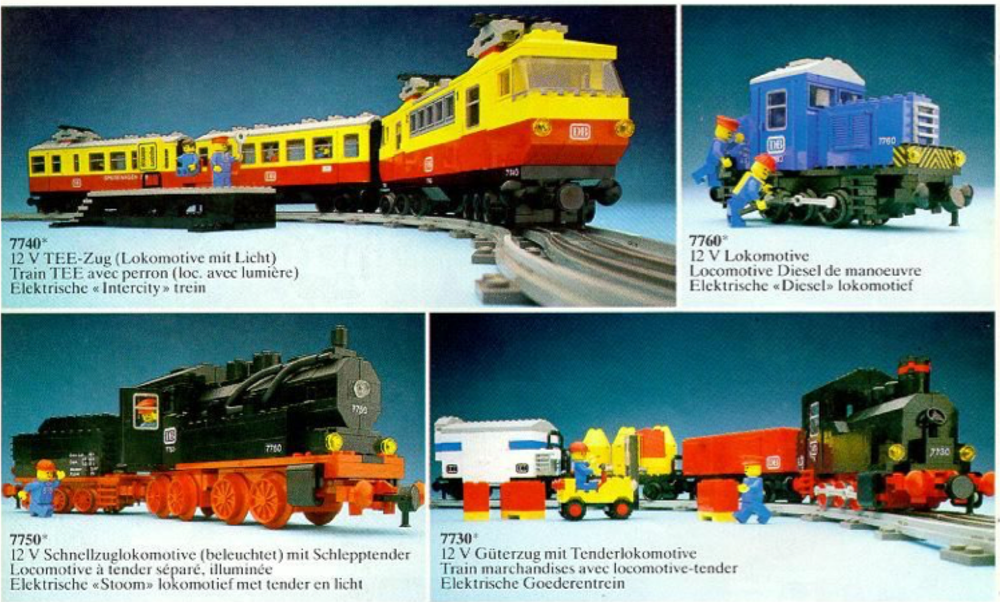
The transition to 12V electric trains powered by two centre metal rails came with the introduction of a new motor bogie. This bogie was compact, powerful and versatile. Moreover, it came bundled with a new coupling rod element (x460)—and not just one pair but two, as shown in the motor bogie accessory set 7865 shown below:
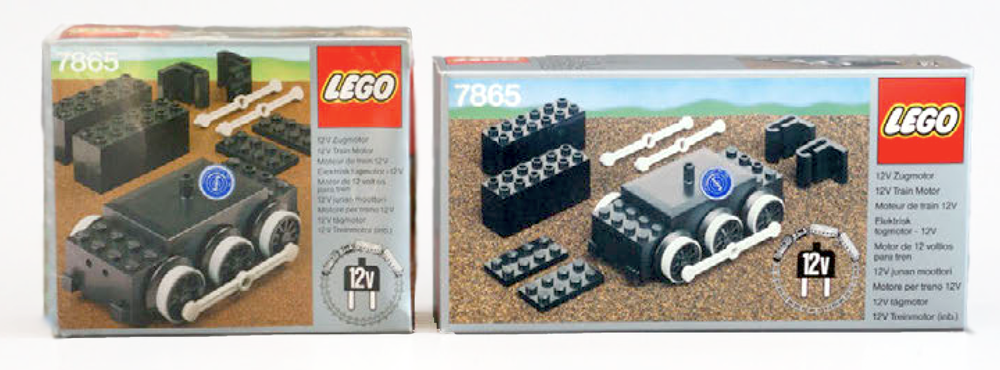
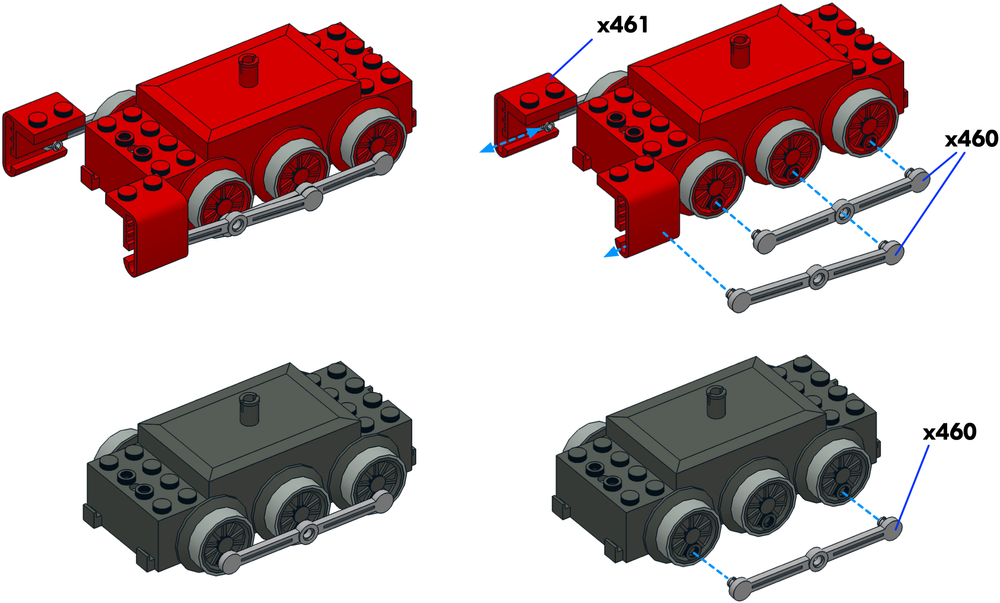
The coupling rod accessory elements could be used either as one pair (like the diesel shunting locomotive set 7760 for example), or more interestingly, as two pairs. One pair connect the driving wheels as coupling rods and another pair act as piston rods. For the piston rod, one end connects to the centre wheel and the other end slides in a confined channel within a bespoke steam cylinder element (x461).
The Dark Era
With the retirement of the 12V system in the early 1990s came the transition to the metal rail 9V system. This system is deservedly praised for the introduction of metal rails; however from the perspective of steam train builders, it can somewhat be considered a “dark age”!
Apart from the new metal track, LEGO train builders had little to no components to build detailed and convincing steam locomotives. Fundamental elements such as larger diameter wheels and coupling rods were simply unavailable. Thus, for many years, steam trains tended to look like this...

Fan Community to the Rescue
Salvation for steam train fans came from a notable source: the LEGO train fan community itself. Ben Fleskes from Portland, Oregon in the USA took it upon himself to design a family of professionally designed injection molded steam train wheels. Big Ben Bricks (BBB) offered steam train builders multiple diameters of both flanged and blind driver wheels as well as offering them in a variety of colours.
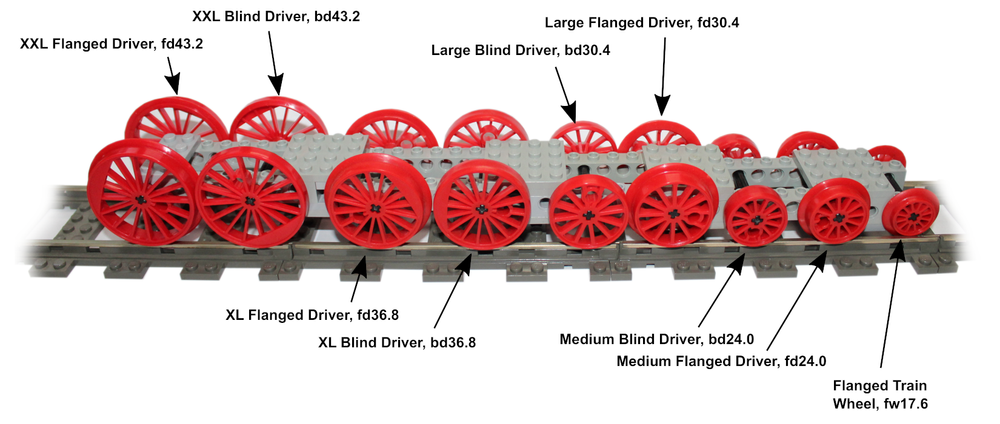
The impact of BBB Wheels on the LEGO train community cannot be overstated—it was quite simply a game changer. Almost immediately, stunning steam locomotives were being made by LEGO train fans in ways that were simply impossible before.
However, even with the availability of wheels addressed, there was still an issue with representing coupling rods. Given that the wheel mounting point for coupling rods was an exposed Technic hole, implementing coupling rods required the use of mating Technic elements, examples of which are shown below:
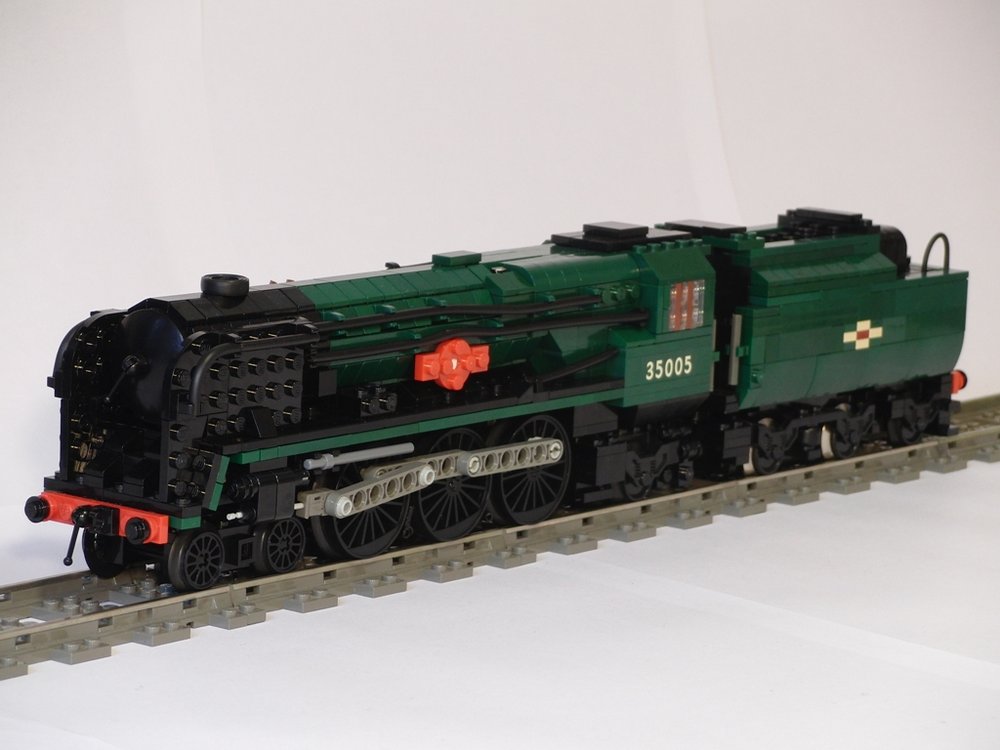
Merchant Navy 4-6-2 by Andrew Harvey
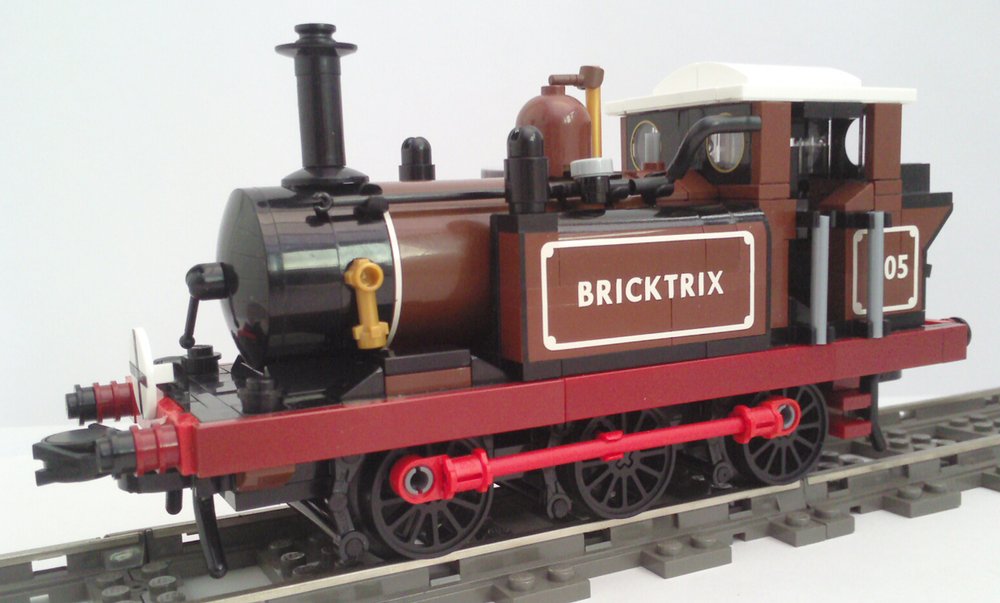
Class A1X “Terrier” 0-6-0 By Carl Greatrix
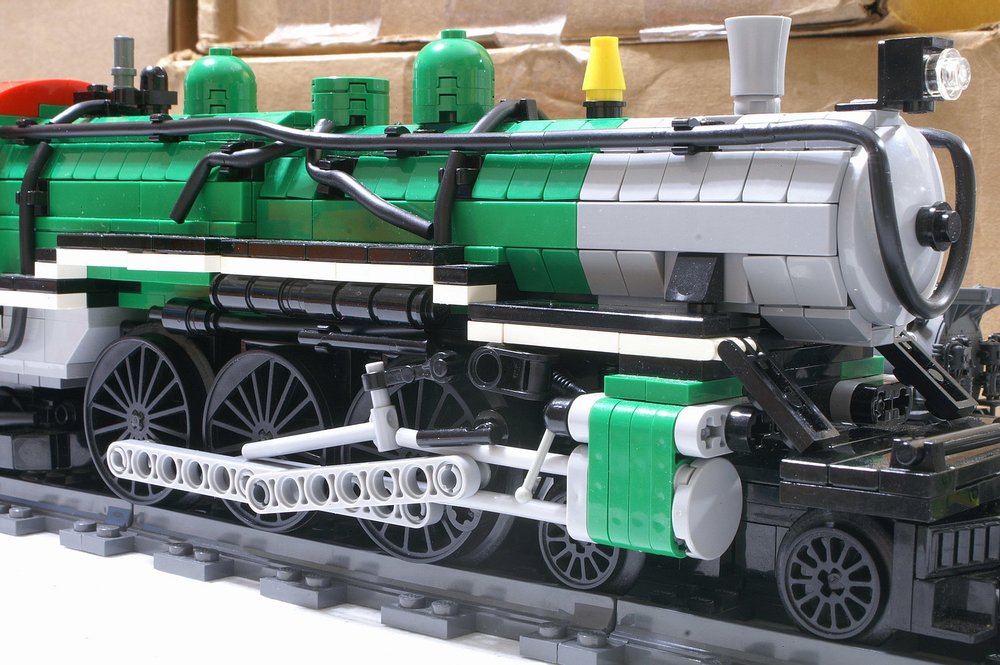
Texas State Railroad #500 4-6-2 By Anthony SavA
Steam train builders have definitely maximized what was possible with both Technic and System elements to represent coupling rods and in some cases even valve gear details. However, the visual aesthetic of Technic “thin” lift arms does stand out against the backdrop of increasingly detailed and stunning models.
Once again, the fan community has innovated alternatives. With the advent of desktop/hobby 3D printing, the possibility of fabricating custom LEGO-compatible elements has become a thriving community of innovation and creativity. In particular, the availability of 3D-printed bespoke coupling rod elements offered even more aesthetic and functional possibilities for steam locomotive builders. One notable supplier of these is legendary LEGO train fan Ben Coifman of Trained Bricks:
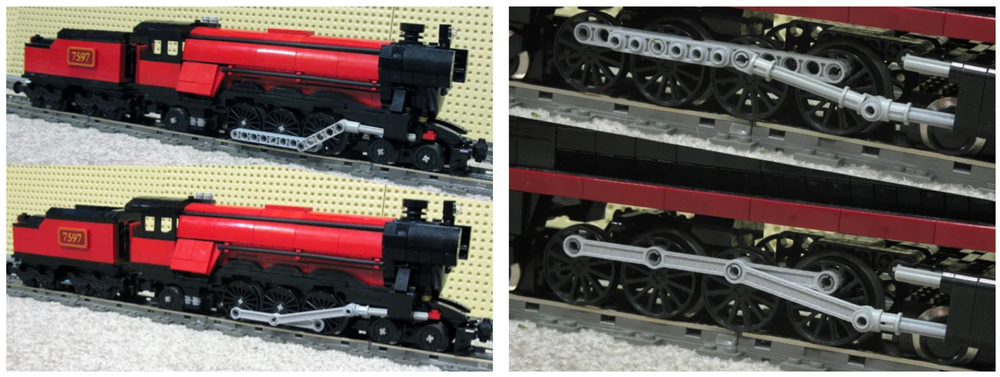
Custom 3-D printed coupling rods as a direct replacement of Technic lift arms. (from Trained bricks)
Advanced Topics
To illustrate more advanced applications of representing steam locomotive coupling rods, I’ll show an example of my process of building the steam locomotive “Tornado”. I built this locomotive in 2014, and it is based on the British LNER Class A1 “Peppercorn” 4-6-2 locomotive—specifically, the newly built, privately funded copy by the A1 Locomotive Trust.
The first part of my process was to establish the scale. This would determine key attributes such as wheel base, wheel sizes, and other key geometry.

With the scale established at approximately 1:40, this set the driving wheelbase axle-to-axle centres at 6 studs with Big Ben Bricks XL driver wheels. At a minimum, I was going to require a custom coupling rod and piston rod. However, I wanted to take the representation of the side rods one step further and have a working representation of the so-called Walschaerts valve gear.
Referring to the discussion above about the reciprocating action of steam in the cylinder, this reciprocating valve configuration is called the Walschaerts valve gear, conceived by its namesake, Belgian railway engineer Egide Walschaerts in 1844. I made a diagram (shown below) to explore the relative geometry of the wheels and side rods at each 90º phase of the driving wheel rotation. This established the extent of linear and rotational travel of each component.
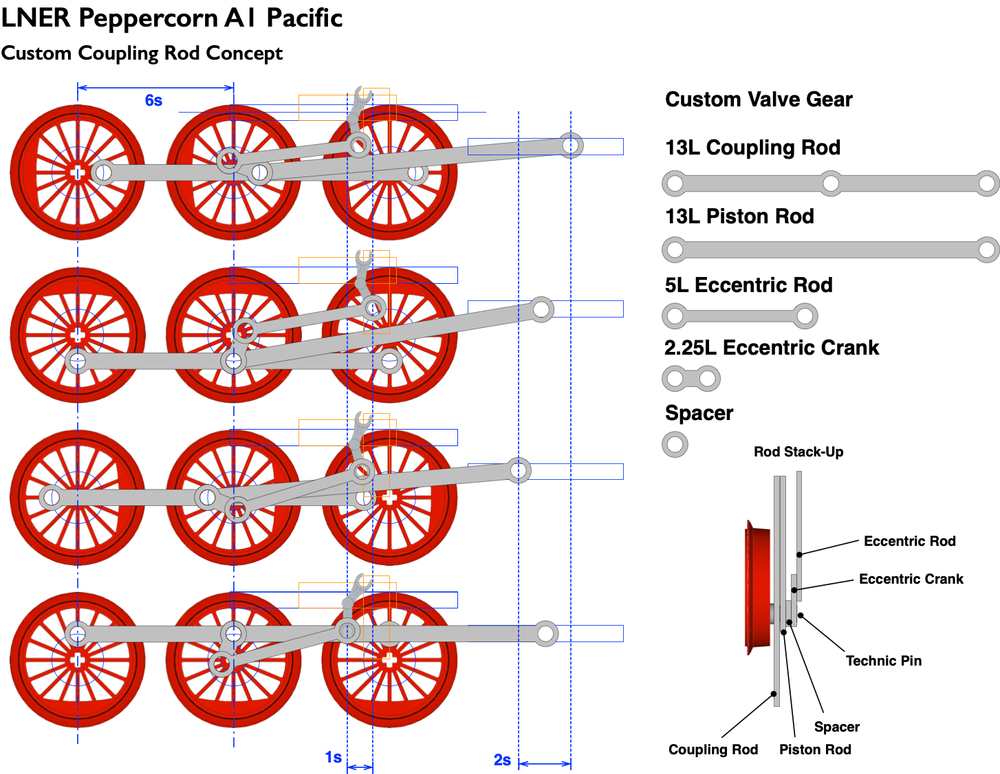
With the arrangement of side rods established, I then proceeded to design a set of custom rod components using a combination of custom machined plastic elements and heavily modified LEGO donor parts. The design and arrangement of these elements is shown below:
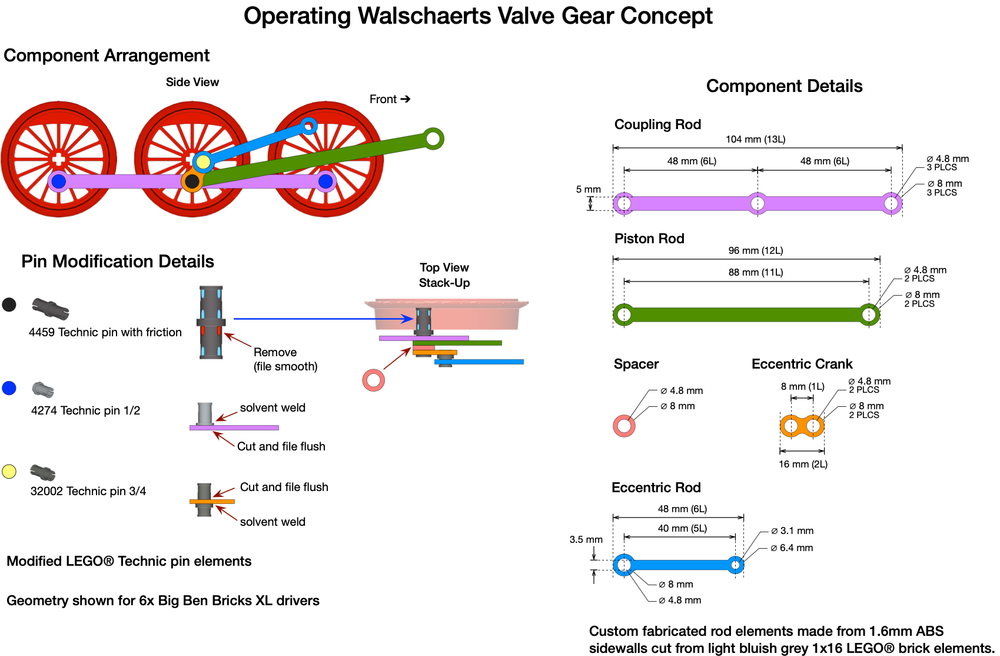
In total, I made 5x custom side rod components. Each was machined out of sacrificial ABS plastic from the walls of 1 x 16 light bluish grey LEGO bricks. The complete locomotive build is shown below with all of the finished side rod components:
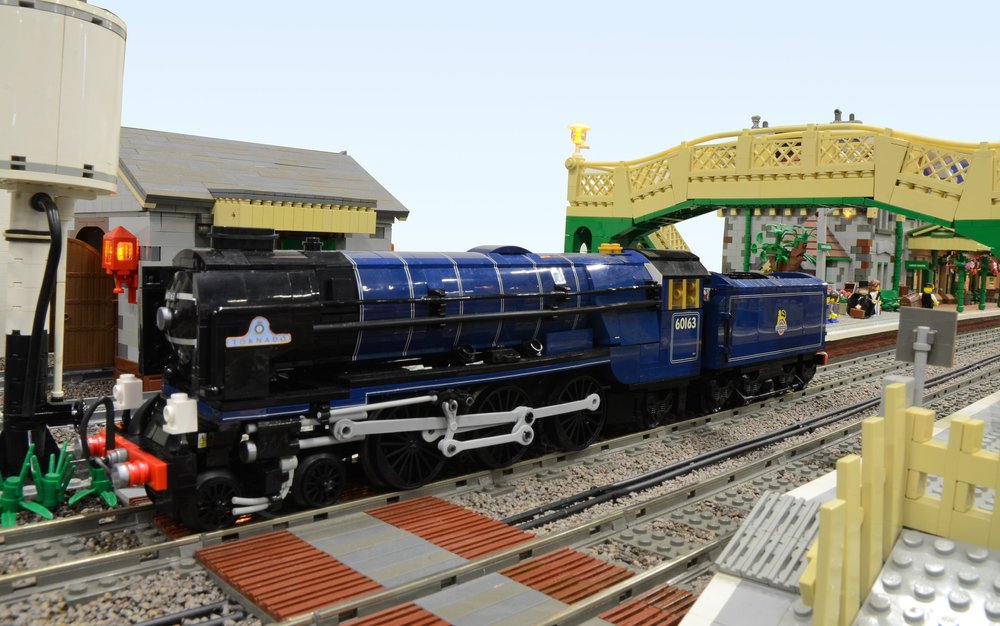
Today: The Orient Express
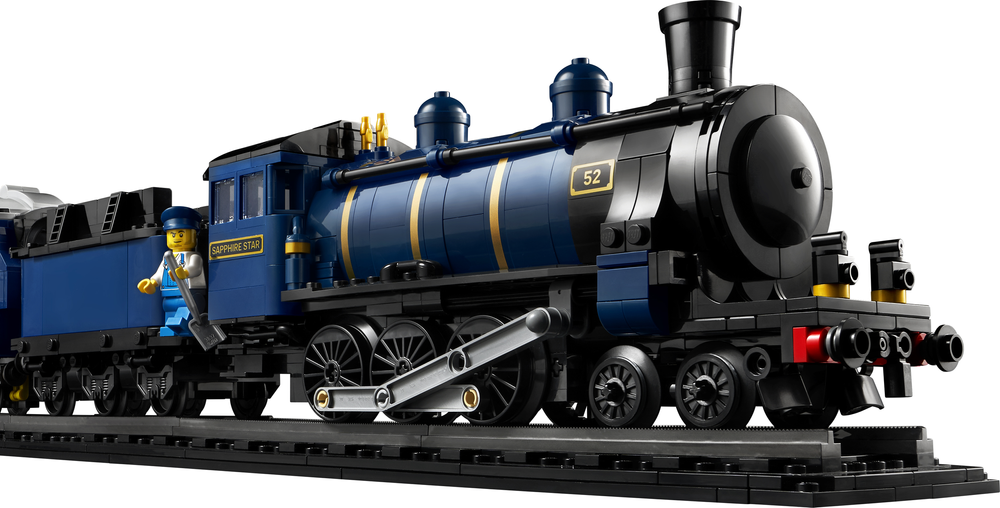
LEGO 21344 ORient Express. I Guess I am not the only one who loves a dark blue steam engine!
With the much-anticipated arrival of the Orient Express, we now move into what might be a new era of LEGO trains—new, in that we have official LEGO train set models built with a level of detail and at a scale normally only seen in MOCs of seasoned LEGO train fans.
Furthermore, with the advent of the new steam train rod element, the opportunity to represent realistic coupling/side rods on a steam locomotive is now easier than ever. Although we have only one length of this new element at 9 studs long, it can be used with LEGO standard steam drivers and BBB Medium wheels as follows:
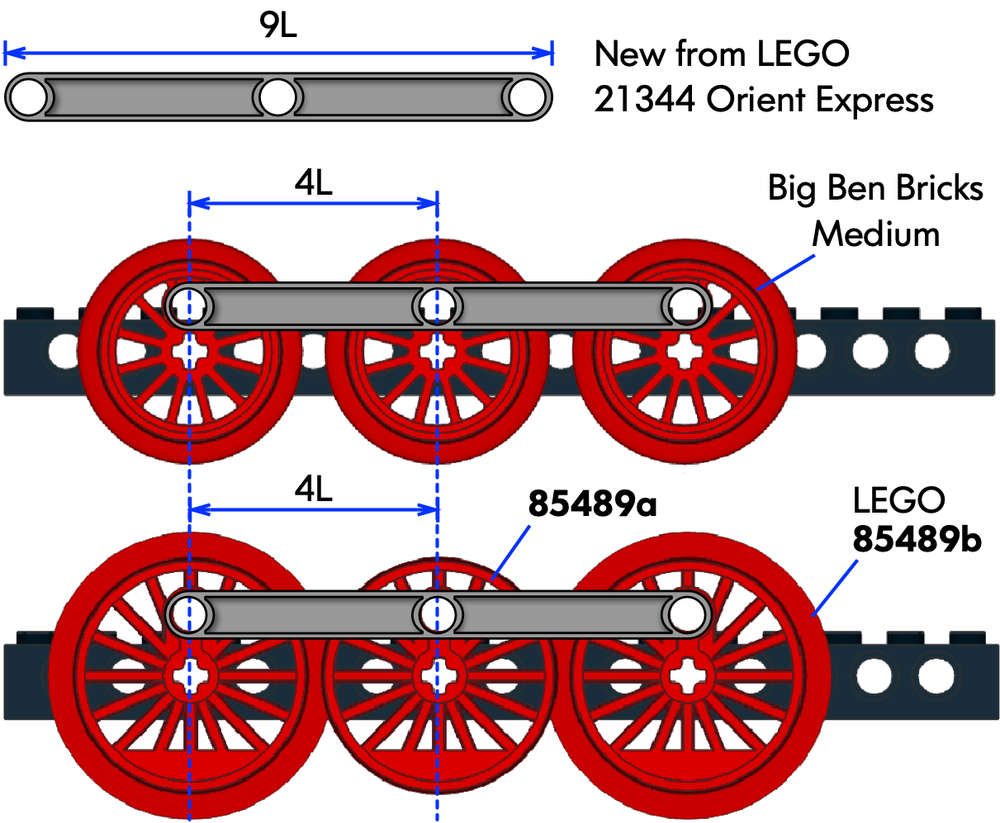
And LEGO knows how much the train community has been waiting for this element. At the recent Recognized Fan Media Days, one of the designers of the Orient Express Jordan Scott spoke about the new coupling rod element: “We knew that the coupling rod has been a very sought-after piece, but also the way we’ve solved it before does have some quality issues and tends to separate slightly. So making one piece that really holds it all together was really good for the quality.”
More to Come?
This might be wishful thinking on my part, but could this new element be the start of more to come? The design of this element is geometrically harmonious with the thin Technic lift arm, and its clean design is versatile enough to be used with other subject models besides steam trains. It would not look out of place in many Technic models of vehicles, machinery, and fixed structures. Shown below are a few representative steam train geometries that could be satisfied with just two other length options (10L & 11L):
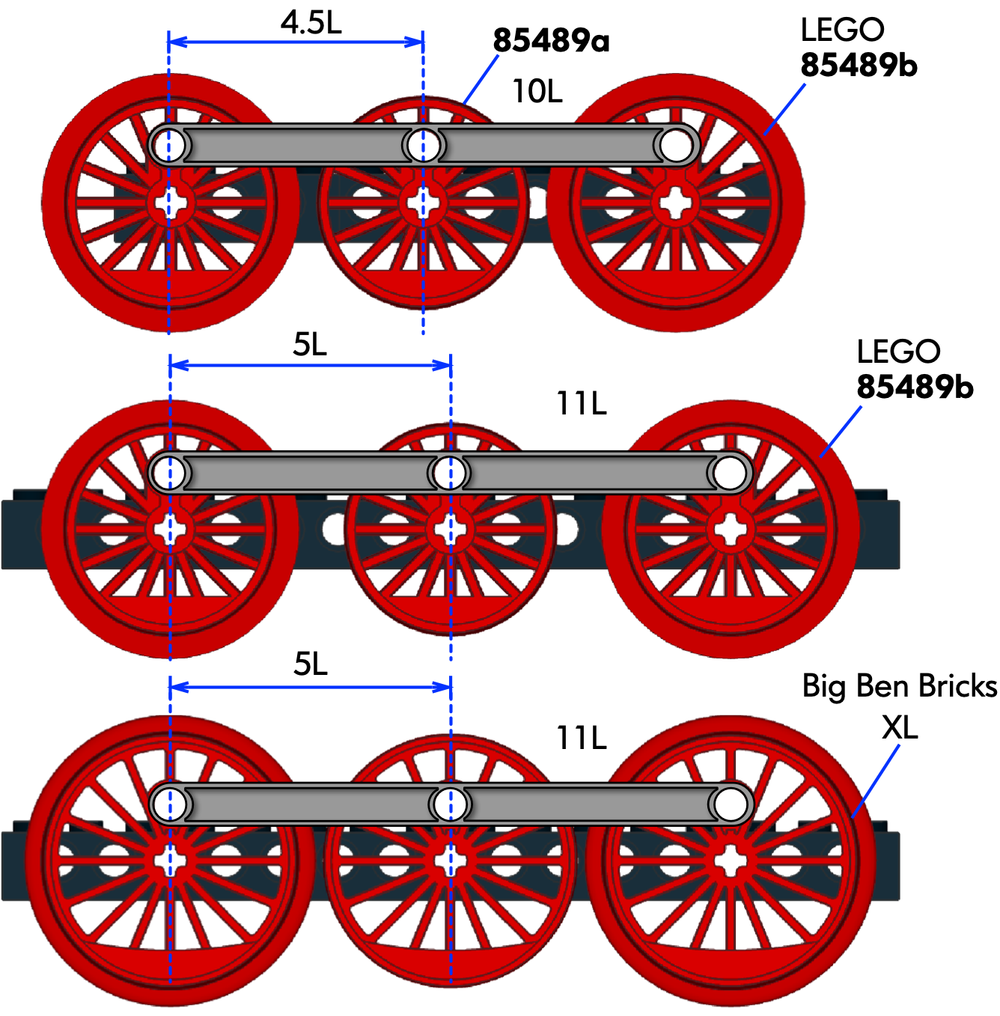
I did not expect this topic to cover so much ground, but I am glad that it did. Or rather, I am glad that the trigger was the introduction of yet another wonderful and special dark blue LEGO train! Years from now, I am sure that The Orient Express will join the ranks of the “Emerald Night” as a classic and much sought after LEGO train set—although hopefully this will be another milestone of many special LEGO train releases yet to come.
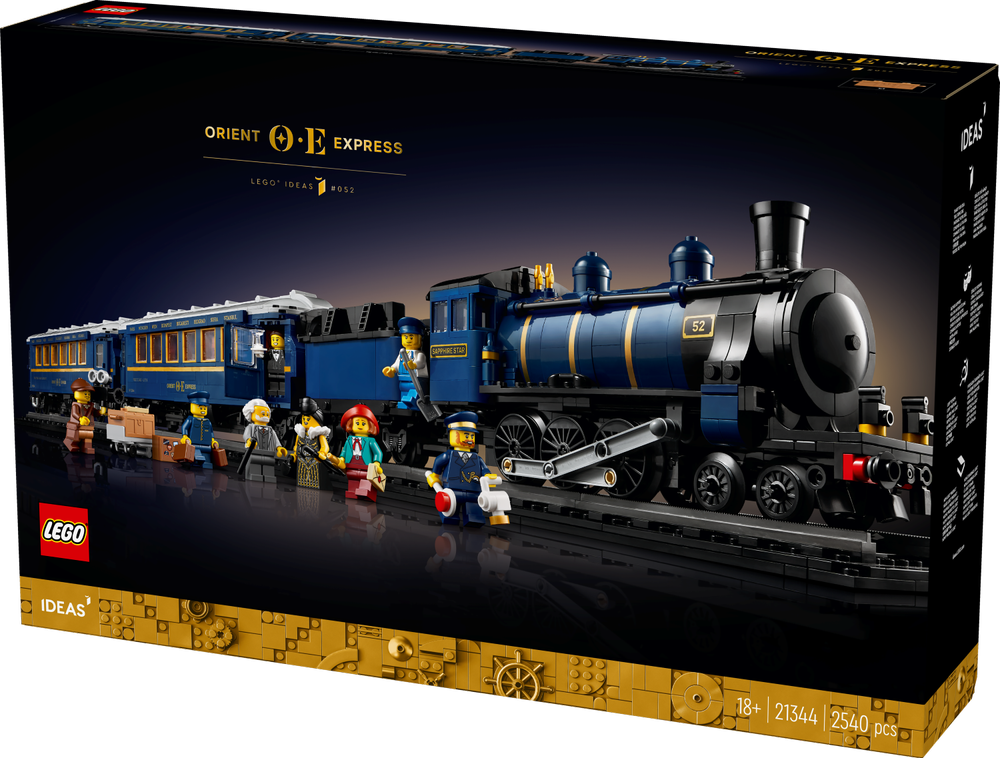
The LEGO Ideas Orient Express (21344) will be available on December 1st for around $300 US / $390 CAN / £260 UK / $470 AU / €300 EU.
DISCLAIMER: This set was provided to BrickNerd by LEGO. Any opinions expressed in this article are those of the author.
What else could LEGO coupling rods be used for? Let us know below.
Do you want to help BrickNerd continue publishing articles like this one? Become a top patron like Charlie Stephens, Marc & Liz Puleo, Paige Mueller, Rob Klingberg from Brickstuff, John & Joshua Hanlon from Beyond the Brick, Megan Lum, Andy Price, Lukas Kurth from StoneWars, Wayne Tyler, Monica Innis, Dan Church, and Roxanne Baxter to show your support, get early access, exclusive swag and more.